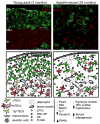Changes in primary lymphoid organs with aging
- PMID: 22559987
- PMCID: PMC3415579
- DOI: 10.1016/j.smim.2012.04.005
Changes in primary lymphoid organs with aging
Abstract
Aging is associated with decreased immune function that leads to increased morbidity and mortality in the elderly. Immune senescence is accompanied by age-related changes in two primary lymphoid organs, bone marrow and thymus, that result in decreased production and function of B and T lymphocytes. In bone marrow, hematopoietic stem cells exhibit reduced self-renewal potential, increased skewing toward myelopoiesis, and decreased production of lymphocytes with aging. These functional sequelae of aging are caused in part by increased oxidative stress, inflammation, adipocyte differentiation, and disruption of hypoxic osteoblastic niches. In thymus, aging is associated with tissue involution, exhibited by a disorganization of the thymic epithelial cell architecture and increased adiposity. This dysregulation correlates with a loss of stroma-thymocyte 'cross-talk', resulting in decreased export of naïve T cells. Mounting evidence argues that with aging, thymic inflammation, systemic stress, local Foxn1 and keratinocyte growth factor expression, and sex steroid levels play critical roles in actively driving thymic involution and overall adaptive immune senescence across the lifespan. With a better understanding of the complex mechanisms and pathways that mediate bone marrow and thymus involution with aging, potential increases for the development of safe and effective interventions to prevent or restore loss of immune function with aging.
Copyright © 2012 Elsevier Ltd. All rights reserved.
Figures


References
-
- Dorshkind K. Genetic Regulation of Thymocyte Progenitor Aging. Seminars in Immunology. 2012
-
- de Haan G, Nijhof W, Van Zant G. Mouse Strain-Dependent Changes in Frequency and Proliferation of Hematopoietic Stem Cells During Aging: Correlation Between Lifespan and Cycling Activity. Blood. 1997;89:1543–1550. - PubMed
-
- Hotta T, Hirabayashi N, Utsumi M, Murate T, Yamada H. Age-related changes in the function of hemopoietic stroma in mice. Experimental Hematology. 1980;8:933–936. - PubMed
Publication types
MeSH terms
Grants and funding
- AG035302/AG/NIA NIH HHS/United States
- AG025150/AG/NIA NIH HHS/United States
- BB/H021183/1/BB_/Biotechnology and Biological Sciences Research Council/United Kingdom
- UC6 AI058607/AI/NIAID NIH HHS/United States
- R01 AI082127/AI/NIAID NIH HHS/United States
- P01 AI076514/AI/NIAID NIH HHS/United States
- AI082127/AI/NIAID NIH HHS/United States
- K12 HD043494/HD/NICHD NIH HHS/United States
- AI076514/AI/NIAID NIH HHS/United States
- R01 AG025150/AG/NIA NIH HHS/United States
- HD043494/HD/NICHD NIH HHS/United States
- HHSN272200900059C/AI/NIAID NIH HHS/United States
- R01 AI055001/AI/NIAID NIH HHS/United States
- R01 AG035302/AG/NIA NIH HHS/United States
LinkOut - more resources
Full Text Sources
Other Literature Sources
Medical

